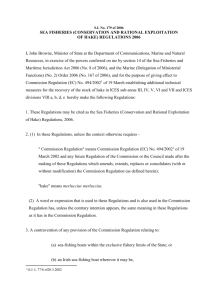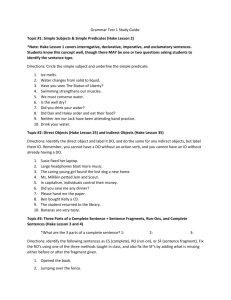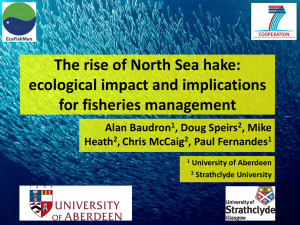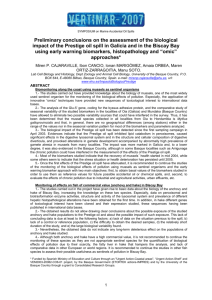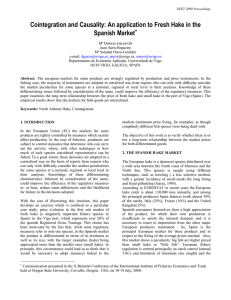THIS PAPER IS NOT TO BE CITED WITHOUT PRIOR REFERENCE... ICES C.M. 2000/Q:12, Ref. R
advertisement
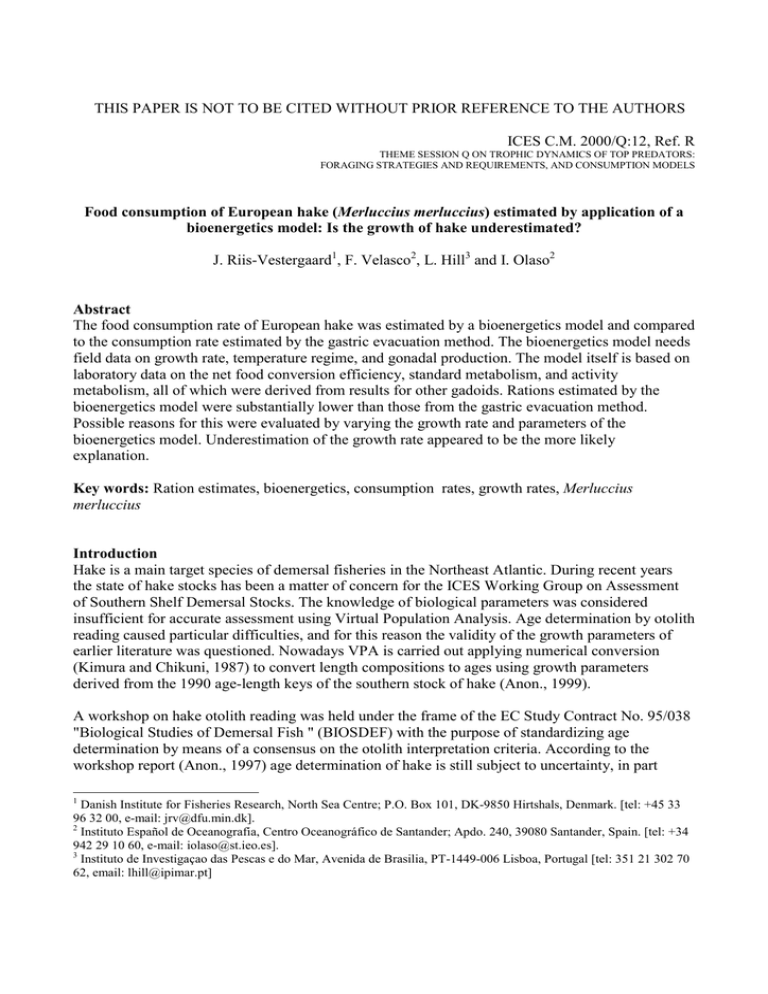
THIS PAPER IS NOT TO BE CITED WITHOUT PRIOR REFERENCE TO THE AUTHORS ICES C.M. 2000/Q:12, Ref. R THEME SESSION Q ON TROPHIC DYNAMICS OF TOP PREDATORS: FORAGING STRATEGIES AND REQUIREMENTS, AND CONSUMPTION MODELS Food consumption of European hake (Merluccius merluccius) estimated by application of a bioenergetics model: Is the growth of hake underestimated? J. Riis-Vestergaard1, F. Velasco2, L. Hill3 and I. Olaso2 Abstract The food consumption rate of European hake was estimated by a bioenergetics model and compared to the consumption rate estimated by the gastric evacuation method. The bioenergetics model needs field data on growth rate, temperature regime, and gonadal production. The model itself is based on laboratory data on the net food conversion efficiency, standard metabolism, and activity metabolism, all of which were derived from results for other gadoids. Rations estimated by the bioenergetics model were substantially lower than those from the gastric evacuation method. Possible reasons for this were evaluated by varying the growth rate and parameters of the bioenergetics model. Underestimation of the growth rate appeared to be the more likely explanation. Key words: Ration estimates, bioenergetics, consumption rates, growth rates, Merluccius merluccius Introduction Hake is a main target species of demersal fisheries in the Northeast Atlantic. During recent years the state of hake stocks has been a matter of concern for the ICES Working Group on Assessment of Southern Shelf Demersal Stocks. The knowledge of biological parameters was considered insufficient for accurate assessment using Virtual Population Analysis. Age determination by otolith reading caused particular difficulties, and for this reason the validity of the growth parameters of earlier literature was questioned. Nowadays VPA is carried out applying numerical conversion (Kimura and Chikuni, 1987) to convert length compositions to ages using growth parameters derived from the 1990 age-length keys of the southern stock of hake (Anon., 1999). A workshop on hake otolith reading was held under the frame of the EC Study Contract No. 95/038 "Biological Studies of Demersal Fish " (BIOSDEF) with the purpose of standardizing age determination by means of a consensus on the otolith interpretation criteria. According to the workshop report (Anon., 1997) age determination of hake is still subject to uncertainty, in part 1 Danish Institute for Fisheries Research, North Sea Centre; P.O. Box 101, DK-9850 Hirtshals, Denmark. [tel: +45 33 96 32 00, e-mail: jrv@dfu.min.dk]. 2 Instituto Español de Oceanografía, Centro Oceanográfico de Santander; Apdo. 240, 39080 Santander, Spain. [tel: +34 942 29 10 60, e-mail: iolaso@st.ieo.es]. 3 Instituto de Investigaçao das Pescas e do Mar, Avenida de Brasilia, PT-1449-006 Lisboa, Portugal [tel: 351 21 302 70 62, email: lhill@ipimar.pt] 2 because there seems to be a high incidence of "false" hyaline rings. Therefore, even the most recent growth parameters based on the recommended criteria may underestimate the true growth rate of hake. Hake was included in the EC Contract No. FAIR-CT 95-0604 "Consumption Rates of Predatory Fish Relevant for Multispecies Assessment in the North Sea and the Atlantic off Spain and Portugal" (CORMA). A preliminary report on hake consumption rates estimated by the gastric evacuation method (GEM) was published by Velasco & Olaso (2000). The present paper contains consumption rates estimated by a bioenergetics model (BEM) which needs field data on growth rate, temperature regime, and gonadal production. The model itself is based on laboratory data on the net food conversion efficiency, standard metabolism, and activity metabolism, all of which were derived from results for other gadoids. The initial BEM estimate was lower than the GEM estimate. Possible bioenergetic reasons for this were evaluated by varying parameters of the bioenergetics model and of the growth rate equation. Underestimation of the actual growth rate in the field appeared to be the more likely explanation. Materials and methods The temperature regime of hake The distribution of hake by age and season in ICES division VIIIc is not known well enough to enable the calculation of a representative temperature regime. Mean temperatures by age class and quarter, used for the consumption estimates were calculated for hake in ICES division IXa. The temperatures were calculated by dividing this area into 58 30nm squares. Each square was divided into 9 depth groups (0-50m, 50-100m, 100-150m, 150-200m, 250-350m, 350-600m, 600-1000m and +1000m). Bottom temperature data have been recorded by CTD during routine surveys in this area since 1990. These data were used to calculate an average temperature for each depth layer present by square and quarter. 7.600 hake sampled during the years 1997 to 1999 were each attributed to a geographical square and to a depth stratum. Each predator was also attributed an age using deterministic age-length keys (Hilborn & Waters 1992). The average temperature T for each predator age class and quarter was thus calculated using weighted averages taking into consideration the number of individuals of each age group collected per depth range and per square as follows: T = ( ∑ T j × Nj ) / ∑ Nj where Tj is the temperature and Nj the number of individuals in the age group collected in the jth combination of depth range and square. Parameters of the von Bertalanffy growth equation, based on the otolith reading criteria in Anon. (1997), were kindly supplied by Dr. C. Piñeiro (pers. comm.): L = L∞ × (1 - exp(-k × (t + t0))) = 120.5 × (1 - exp(-0.076 × (t + 1.24))) where L is the length (cm) and t the time (y). The value of parameter k is slightly higher than the value of 0.070 published by Piñeiro et al. (1997). Dr. C. Piñeiro also supplied quarterly length- 3 weight relationships: Qt. 1: W = 0.0052 × L 3.06 Qt. 3: W = 0.0048 × L 3.10 Qt. 2: W = 0.0042 × L 3.13 Qt. 4: W = 0.0045 × L 3.11 where W is the wet weight (g). The energy density of hake by length class and quarter was measured on specimens collected during research surveys or on board commercial vessels during quarters 2 and 3. The fish were frozen whole on board and brought to the laboratory, where the fish were thawed, length measured and weighed. Gonads were removed from the soma and weighed. Each fish was homogenized, and a sample of this homogenate and the separated gonads were freeze dried until constant weight. The energy density of gonads and soma was measured separately by bomb calorimetry, and the overall energy density of the predator was calculated. A linear regression was fitted to the pooled data enabling the total energy content E (MJ) of a hake to be calculated as: E = W × ED × 10 -3 (1) where ED is the energy density (kJ/g ww) as a function of length. Gonadal production of hake No data on the gonadal production of male hake were found - it was simply assumed that male energy consumption for reproduction equals that of females of the same size. Hislop & Bell (1987) measured the energy of eggs of six gadoid species producing pelagic eggs without oil globules, averaging at 24.4 ± 0.6 kJ g -1 ash free dry weight. This is slightly higher than a standard figure of 23.7 kJ g -1 for protein (Davis & Warren, 1971), indicating that gadoid eggs without oil globules contain little lipid. For each of the six gadoid species, the energy density was calculated by dividing the egg energy from Hislop & Bell (1987) by the egg volume, calculated using the middle of the range of diameters reported by Russell (1976). Hereby an average energy density of 1.84 ± 0.09 kJ ml -1 was obtained. The eggs of hake contain oil globules. The volumes of the oil and the oil-free part were calculated using the middle of the ranges of the oil globule and egg diameters from Russell (1976). Subsequently, the energy content of an egg Ee was calculated applying the above mentioned energy density to the oil-free part, and a standard energy density of 39.6 kJ g -1 to the oil globules (Davis & Warren, 1971), combined with a specific gravity of 0.9 g ml -1 oil. A length-fecundity relationship was taken from Perez & Pereiro (1985): F = 1.393 × L 3.27 where F is the number of eggs per spawning season for a female of length L. The maturity index IM of hake (the proportion of fish attaining sexual maturity) used in VPA hitherto was based on females. Parameters of a logistic function IM = 1/(1 + exp(a - b × L)) 4 describing the maturity index versus length separately for each sex, based on almost 18.000 specimens collected in ICES divisions VIIIc and IXa during the spawning season, were taken from Cardador et al. (1999). An approximation of the sex ratio of hake as a function of length was derived from the same paper. Thus the maturity index of combined sexes could be estimated as the average between males and females weighted by the sex ratio, and the gonadal production of an average hake per spawning season was estimated as IM × F × Ee The bioenergetics food conversion model The following bioenergetics food conversion model was used to estimate the food consumption of hake (kJ/day): Gs = (1 - α) β C - Ms - Ma - Gg = κ f h W m e d T - l W n e r T - s W q U v - P(t) W p (2) where Gs is the energy increment of the soma. β is the absorbed part of the consumed food, α the total cost (as a proportion of the absorbed part) associated with processing of ingested food, and κ = (1 - α) β is the net food conversion efficiency. C is the food ration, calculated as the product of the feeding level f ( 0 ≤ f ≤ 1 ) and the maximum sustainable ration Cmax , which is substituted by h W m e d T . Numerical values of the parameters κ, h, m, and d were derived from laboratory experiments with saithe (Pollachius virens) in the weight range 0.7 to 2.8 kg, and at a temperature range of 7 to 10 οC (Andersen, 2000). Ms = l W n e r T is the standard metabolism, derived from data on respiration of cod in the weight range 100-200 g at 10 and 15 οC (Schurmann & Steffensen, 1997) combined with generally accepted values of n = 0.75 and r = 0.08. Ma = s W q U v is the energy cost of swimming where U is the swimming speed in m/s, adapted from a saithe BEM model. The parameters s, q, and v were estimated from measurements of the energy consumption of three size classes of saithe swimming at various fixed speeds (unpublished data supplied by Dr. C. S. Wardle, used in Andersen (2000)). Field observations (Sarno et al., 1994) have shown that saithe spend most of the time swimming at speeds around 0.5-1 body lengths/s, which in the hake model was approximated by substituting U with the formula for optimum swimming speed (the speed that minimizes (Ms + Ma) per unit distance) as a function of length, derived for sockeye salmon at 15 οC by Ware (1978): Uopt = 0.0735 × L 0.434 The average swimming speed of saithe during foraging periods in the field (Pedersen, submitted) was close to the maximum sustained speed of saithe Umax = 0.295 × L 0.34 as reported by He & Wardle (1988); this formula replaced U in the present model during the time of foraging. No literature data to elucidate the proportion of time spent at each of the two activity levels seem available. With saithe the time proportion was estimated by varying it until the BEM ration matched that of the GEM method. The result was 4.5 % of time spent at the high activity level (Andersen, 2000); this proportion was also used for the initial BEM ration estimate of hake. 5 Gg, the gonadal production, was expressed as a cyclic function with exponential growth from onset of gonadal maturation (assumed to be primo January) reaching the final value at the peak of the spawning season (medio April) when release was assumed to occur instantaneously. Gonadal growth was then zero until onset of the following maturation period. Consumption estimates Quarterly consumption rates were estimated by a computerized iteration of equation (2), increasing the energy (Gs + Gg ) in 91 daily steps with the feeding level f set to some low value, starting from the energy content E on the first day of the quarter according to equation (1). The computation was then repeated with increasing values of f, and the value f' was considered a solution if the computed energy content E(f') on the first day of the next quarter was equal to or smaller than E calculated by equation (1), and E(f'+0.001) larger. The quarterly ration would then be the sum of the 91 daily rations f''h W m e d T . The life span by which to compare total BEM and GEM rations was delimited to age class 1 quarter 1 through age class 5 quarter 4, because older hake in Velasco & Olaso (2000) are treated as 6+. The initial BEM 5 years estimate, calculated by parameter values taken directly from the sources mentioned above, appeared substantially lower than the GEM estimate. An explanation based on the bioenergetics model (implicitly assuming that the GEM estimate was the more reliable one) was sought by varying parameter values one at a time, until the BEM 5 years estimate was equal to the GEM estimate ± 1 %. The conversion efficiency κ was decreased, the coefficient l of the standard metabolism was increased, and the proportion of time spent at the high activity level was increased. The way of varying parameters of the von Bertalanffy growth equation was linked to the otolith reading difficulties (Anon., 1997) which imply that the likelihood of a hake having extra hyaline rings will increase with age. The likelihood at age 1 was defined as zero, so each time the growth rate parameter k was increased, the t0 parameter was adjusted subsequently until the length on the first day of year 1 was equal to the length calculated by the original parameters supplied by Dr. Piñeiro. Weight, energy density, gonadal production, maturity index, and sex ratio were automatically adjusted to the increased growth rate when estimating the new 5 years consumption. Results Average temperatures by age class and quarter of the hake stock in ICES division IXa were: Age 1 2 3 4 5 Qt1 13,8 14,0 14,2 14,1 13,9 Qt2 13,9 13,4 13,1 13,2 13,2 Regressing the energy density on length resulted in ED = 3.79 + 0.0336 × L Qt3 13,4 13,6 13,4 13,3 13,1 Qt4 14,2 14,3 14,4 14,4 14,7 6 The energy of a hake egg was estimated as Ee = 1.32 kJ/egg The sex ratio of hake was approximated as 60 % males at L < 47 cm, decreasing linearly to 0 % during the interval 47 cm ≤ L ≤ 57 cm, and being 0 % males at L > 57 cm. The maturity index of combined sexes was, accordingly, close to a simple mean value of males and females for smaller hake, gradually becoming coincident with the index of females for large hake (Figure 1). The initial BEM ration estimate, based on the original parameter values, is compared to the GEM estimate in Figure 2. The 5 years BEM ration equals 68 % of the GEM ration. Figure 3A shows yearly GEM rations, which are estimated independently of any bioenergetic assumptions, plotted versus fish weight for hake and North Sea saithe (Andersen, 2000). Judging from the overlapping parts of the curves, hake consume more than saithe of a similar size. This is to be expected due to the higher ambient temperature, if food availability is not a limiting factor. Assuming a priori that GEM rations are reliable, there must be some bioenergetic reasons for hake to have a lower growth rate than saithe, as estimated by current von Bertalanffy parameter values. An obvious possibility is the higher temperature regime of hake which increases standard metabolism. The temperature-induced extra cost was calculated as the difference between BEM rations estimated for hake at the temperature regime of ICES area IXa and at 6.5 οC, the mean temperature experienced by adult North Sea saithe (Andersen, 2000). The result of subtracting the difference from the GEM rations of hake is included in Figure 3A. These rations are closer to, but nevertheless higher than saithe rations so the different growth rates of the two species cannot be explained by the influence of temperature on standard metabolism. The value of 0.66 for the net conversion efficiency κ, derived from growth experiments with saithe, (Andersen, 2000) had to be decreased to 0.45 to obtain a 5 years BEM hake ration equal to the GEM ration. The initial value of the parameter l for standard metabolism was 5.15, derived from cod respirometry (Schurmann & Steffensen, 1997). This parameter value had to be increased to 11.2 to obtain correspondence between the BEM and the GEM 5 years rations for hake. The 4.5 % of time spent at the high activity level inherited from the saithe bioenergetics model resulted in a total 5 years activity cost of 6.1 MJ for hake, i. e., 15 % of the 5 years consumption in the initial hake BEM estimate. The BEM estimate could be increased to the GEM level by increasing the time of high activity to 20.5 %. In this case the cost of 5 years activity amounted to 18.7 MJ; 31 % of the new, increased consumption estimate. Finally the effect of increasing the growth rate was investigated, maintaining all parameter values of the right hand terms of equation (2) at the original values. The original value of the growth rate parameter k, 0.076, had to be increased to 0.103 in order for GEM and BEM 5 years rations to coincide, simultaneously decreasing t0 from 1.24 to 0.58 in order to keep the length at the start of age 1 constant. The effect of the revised growth parameters on the specific growth rate is included in Figure 3B. The new predicted weight increment of hake is still below that of similarly sized North Sea saithe, although the growth rate parameter k was increased by 36 % . The weight and 7 length increment of hake, predicted by the current as well as the revised von Bertalanffy parameters, are depicted with those of saithe in Figure 4A-B. Even the increased growth rate implied by the revised parameters is below that of saithe. Discussion The value of the net conversion efficiency estimated from experiments with saithe is similar to values for cod (Gadus morhua) derived from the literature: 0.62 from Hansson et al. (1996) and 0.67 from Krohn et al. (1997) while Brett & Groves (1979) derived a value of 0.59 generally applicable to active carnivorous fish. The value of 0.45, which was necessary to tune BEM rations to GEM rations, seems out of the range for carnivorous fish. From a biochemical point of view the costs of converting prey fish tissues into predator tissues is not expected to vary much between predators eating similar diets. The net conversion efficiency is therefore considered an unlikely candidate to explain the apparently low growth rate of hake. Comprehensive measurements of gadoid standard metabolism using modern techniques with good time resolution seem scarce in the literature. The use of the cited cod results for hake is favoured because the experimental temperatures encompassed the temperature range of hake, thus minimizing errors due to extrapolation. A 117 % increased standard metabolism may be rejected as the reason for the low growth rate, assuming that the true energy cost of the basic physiological functions are similar between similar species The credibility of the activity scenario necessary to obtain equal BEM and GEM rations is somewhat difficult to evaluate. The two-level activity concept was based on actual field observations of saithe swimming at high speeds when not schooling and at low speeds otherwise; conceptually the high speeds were attributed primarily to foraging. Applying this concept to hake and comparing the two activity scenarios lead to the conclusion that the computer exercise expanding the high activity level from 4.5 to 20.5 % of time implies no benefit to the fish. Neither somatic growth nor gonadal output is increased; the increase in consumption is all used to fuel the increase in activity. One might also reject the idea of an organism performing at its maximum activity level for 20 % of its time. The increased growth rate of hake predicted by the revised von Bertalanffy equation parameters is clearly not beyond reasonable biological limits, as it is still lower than the growth rate achieved by North Sea saithe. It is relevant at this point to comment on the a priori assumption that hake GEM rations are valid. These rations are based on two principal elements. One is the content of hake stomachs sampled in the field. The results may be subject to sampling bias, although sampling was comprehensive with more than 11000 stomach contents analysed; this possibility eludes analysis. The other is the assumption that the rate at which hake digest a meal is predicted with accuracy by the gastric evacuation model validated for saithe and whiting (Andersen, 1998, 1999, 2000). The project reported in Andersen (2000) failed to obtain hake for experimental verification of the model. Thus there seems nothing concrete by which to either question or support the GEM ration estimate. On the other hand, there are reasons to question the initial BEM estimate because it may be assumed that age determination of hake by otolith reading is biased. The expert report on hake otolith reading (Anon., 1997) states: "Hyaline edge appears very frequently along the year, suggesting a high incidence of false rings associated with summer". If hake, at the average, are younger than determined by otoliths, the parameter values of the growth equation as well as the 8 estimated BEM rations will be biased. None of the original parameter values of the right hand terms in equation (2) were considered likely reasons for the discrepancy between BEM and GEM rations. Consequently, the present authors are inclined to accept the hypothesis of hake growth being underestimated, Acknowledgements Parameters of the von Bertalanffy growth equation and the length-weight relations originated from the BIOSDEF project: "Biological Studies of Demersal Fish". Study contract DG: XIV 95/038. Dr. C. Piñeiro, Instituto Español de Oceanografía, Vigo is thanked for making them available to the authors. Dr. C. S. Wardle, Marine Laboratory Aberdeen, is thanked for making results from saithe swimming respirometry available. References Andersen, N. G. (1998). The effect of meal size on gastric evacuation in whiting. Journal of Fish Biology 52, 743-755. Andersen, N. G. (1999). The effects of predator size, temperature, and prey characteristics on gastric evacuation in whiting. Journal of Fish Biology 54, 287-301. Andersen, N. G. (Ed.) (2000). Final report of project "Consumption Rates of Predatory Fish Relevant for Multispecies Assessment in the North Sea and the Atlantic off Spain and Portugal (CORMA)". EU contract No. FAIR-CT 95-0604. Anon. (1997). Report of workshop on hake otolith age reading. Vigo, 23-27 June, 1997. Anon. (1999). Report of the Working Group on the Assessment of Southern Shelf Demersal Stocks. ICES CM 1999/ACFM: 4, 696 pp. Brett. J. R. & Groves, T. D. D. (1979). Physiological energetics, in Fish Physiology 8, 279-352 (eds W. S. Hoar, D. J. Randall & J. R. Brett). Academic Press, New York. Cardador, F., Morgado, C., Lucio, P., Piñeiro, C., Sainza, C. & Santurtun, M. (1999). New maturity ogive for the Southern Stock of Hake (ICES Divisions VIIIc+IXa). Working Document for the Working Group on Southern Shelf Demersal Stocks, ICES 1999, 9 pp. Davis, G. E. & Warren, C. E. (1971). Estimation of food consumption rates. In Ricker, W. E. (ed.): IBP Handbook No. 3. Methods for assessment of fish production in fresh waters, pp. 227-248. Blackwell Scientific Publications (2nd ed.). Hansson, S., Rudstam, L. G., Kitchell, J. F., Hildén, M., Johnson, B. L. & Peppard, P. E. (1996). Predation rates by North Sea cod (Gadus morhua) – predictions from models on gastric evacuation and bioenergetics. ICES Journal of Marine Science 53, 107-114. He, P. & Wardle, C. S. (1988). Endurance at intermediate swimming speeds of Atlantic mackerel, Scomber scombrus L., herring, Clupea harengus L., and saithe, Pollachius virens L. Journal of fish Biology 33, 255-266. 9 Hilborn R. & C.J. Waters (1992). Quantitative fisheries stock assessment. Choice, dynamics and uncertainty. Chapman and Hall, 570 pp. Hislop, J. R. G. & Bell, M. A. (1987). Observations on the size, dry weight and energy content of the eggs of some demersal fish species from British marine waters. Journal of Fish Biology 31, 120. Kimura, D.K. & Chikuni, S. (1987). Mixtures of empirical distributions: an iterative application of the age-length key. Biometrics 43, 23-35. Krohn, M., Reidy, S. & Kerr, S. (1997). Bioenergetic analysis of the effects of temperature and prey availability on growth and condition of northern cod (Gadus morhua). Canadian Journal of Fisheries and Aquatic Sciences 54 (Supplement 1), 113-121. Pedersen, J. (submitted). Hydroacoustic measurement of swimming speed of North Sea saithe in the field. Journal of Fish Biology Perez, N. & Pereiro, F.J. (1985). Aspectos de la reproducción de la merluza (Merluccius merluccius L.) de la plataforma gallega y cantábrica. Boletín del Instituto Español de Oceanografía 2(3), 39-47. Piñeiro, C., Sainza, M., Loureiro, I. & Trujillo, V. (1997). Preliminar results from the application of the new otolith ageing criteria of European hake from the southern stock. Working Document for the Working Group on Assessment of Southern Shelf Demersal Stocks, ICES 1997. Russell, F. S. (1976). The eggs and planktonic stages of British marine fishes. London: Academic Press Inc. Sarno, B., Glass, C. W., Smith, G. W., Johnstone, A. D. F. & Mojsiewicz, W. R. (1994). A comparison of the movements of two species of gadoid in the vicinity of an underwater reef. Journal of Fish Biology 45, 811-817. Schurmann, H. & Steffensen, J. F. (1997). Effects of temperature, hypoxia and activity on the metabolism of juvenile Atlantic cod. Journal of Fish Biology 50, 1166-1180. Velasco, F. & Olaso, I. (2000). Hake food consumption in the southern Bay of Biscay estimated from a gastric evacuation model. ICES CM 2000/Q:11 Ware, D. M. (1978). Bioenergetics of pelagic fish: theoretical change in swimming speed and ration with body size. Journal of Fisheries Research Board of Canada 35, 220-228. 10 1,0 0,8 0,6 M 0,4 pM C 0,2 F 0,0 0 20 40 60 80 100 Length (cm) FIG. 1. Maturity index of male (M), female (F) and combined sexes (C) of southern stock of hake; the latter weighted by the proportion of males (pM) and females. Yearly consumption (MJ) 25 20 15 10 5 0 0 1 2 3 Age class 4 5 6 FIG. 2. Yearly consumption of southern stock of hake estimated by the gastric evacuation method (GEM) (•) and the bioenergetic model (BEM) (o). The BEM estimate is based on growth rate calculated as L = 120.5 × (1 - exp(-0.076 × (t + 1.24))) Yearly consumption (MJ) 11 50 40 30 20 10 0 0 1 2 3 Weight on 1st July (kg) FIG. 3A. Yearly consumption of North Sea Saithe saithe (▪) and southern stock of hake (•) estimated by the gastric evacuation method (GEM) versus body weight by mid-year. (o) is hake consumption calculated at the temperature regime of saithe.Weight af hake is based on length calculated as L = 120.5 × (1 - exp(-0.076 × (t + 1.24))) Yearly growth (kg) 1 0,8 0,6 0,4 0,2 0 0 1 2 3 Weight on 1st July (kg) FIG. 3B. Yearly growth of North Sea saithe (▪) and southern stock of hake. Growth and weight of hake is based on length calculated as L = 120.5 × (1 - exp(-0.076 × (t + 1.24))) (o), and L = 120.5 × (1 - exp(-0.103 × (t + 0.58))) (•) 12 7 Weight (kg) 6 S 5 4 3 H2 2 H1 1 0 0 2 4 6 8 10 Age (y) FIG. 4A.Growth curves of North Sea saithe (S) and southern stock of hake. Growth of hake is based on length calculated as L = 120.5 × (1 - exp(-0.076 × (t + 1.24))) (H1), and L = 120.5 × (1 - exp(-0.103 × (t + 0.58))) (H2) 100 S Length (cm) 80 H2 H1 60 40 20 0 0 1 2 3 4 5 6 7 8 9 10 Age (y) FIG. 4B.Growth curves of North Sea Saithe saithe (S) and southern stock of hake. Growth of hake is based on length calculated as L = 120.5 × (1 - exp(-0.076 × (t + 1.24))) (H1), and L = 120.5 × (1 - exp(-0.103 × (t + 0.58))) (H2)
